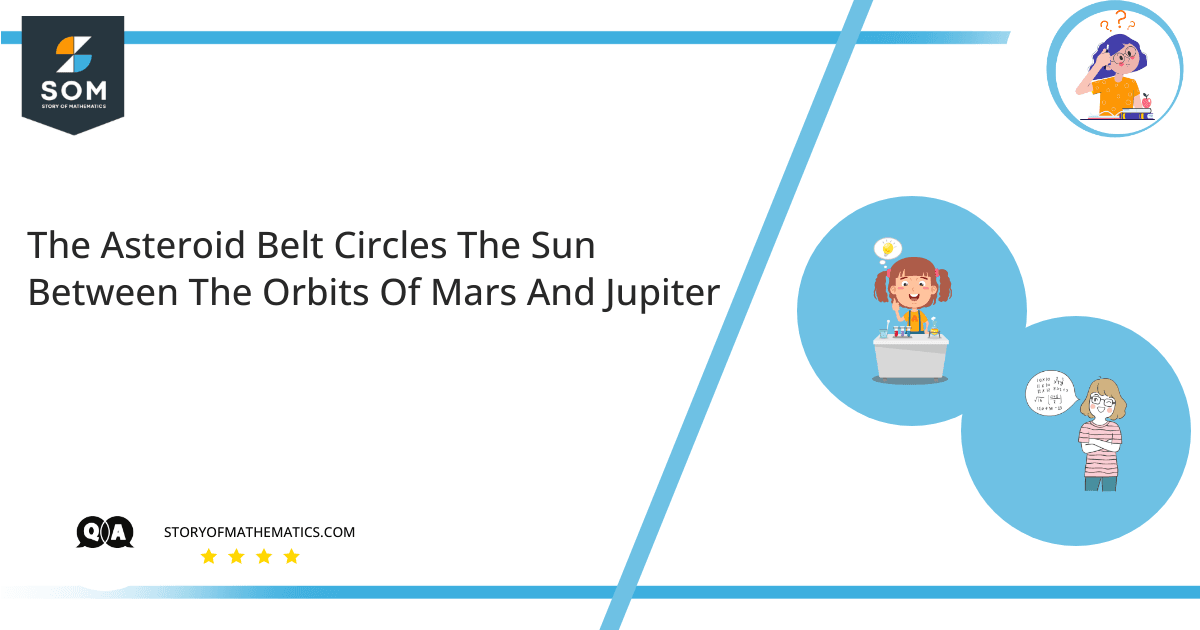
The period of the asteroid is assumed to be $5$ Earth Years.
Calculate the speed of the asteroid and the radius of its orbit.
The aim of this article is to find the speed at which the asteroid is moving and the radius of its orbital movement.
The basic concept behind this article is Kepler’s Third Law for Orbital Time Period and the expression for Orbital Speed of asteroid in terms of Orbital Radius.
Kepler’s Third Law explains that the time period $T$ for a planetary body to orbit a star increases as the radius of its orbit increases. It is expressed as follows:
\[T^2\ =\ \frac{4\pi^2r^3}{GM_s}\]
Where:
$T\ =$ Asteroid Period in Second
$G\ =$ Universal Gravitational Constant $=\ 6.67\ \times\ {10}^{-11}\ \dfrac{Nm^2}{{\rm kg}^2}$
$M_s\ =$ The Mass of the star around which the asteroid is moving
$r\ =$ The radius of the orbit in which the asteroid is moving
The orbital speed $v_o$ of an asteroid is represented in terms of its orbital radius $r$ as follows:
\[v_o\ =\ \sqrt{\frac{G\ M_s}{r}}\]
Expert Answer
Given that:
Time Period of Asteroid $T\ =\ 5\ Years$
Converting the time into seconds:
\[T\ =\ 5\ \times\ 365\ \times\ 24\ \times\ 60\ \times\ 60\ =\ 1.5768\times{10}^8\ s\]
We know that the Mass of Sun $M_s\ =\ 1.99\times{10}^{30}\ kg$.
Using the Kepler’s Third Law:
\[T^2\ =\ \frac{4\pi^2r^3}{G\ M_s}\]
By rearranging the equation, we get:
\[r\ =\ \left[\frac{T^2\ G\ M_s}{4\pi^2}\right]^\frac{1}{3}\]
We will substitute the given values in the above equation:
\[r\ =\ \left[\frac{\left(1.5768\times{\ 10}^8s\right)^2\times\left(6.67\ \times\ {10}^{-11}\ \dfrac{Nm^2}{{\rm kg}^2}\right)\times\left(1.99\times{\ 10}^{30}kg\right)}{4\pi^2}\right]^\frac{1}{3}\]
\[r\ =\ 4.38\ \times\ {10}^{11}\ m\]
\[r\ =\ 4.38\ \times\ {10}^8\ km\]
Now using the concept for orbital speed $v_o$, we know that:
\[v_o\ =\ \sqrt{\frac{G\ M_s}{r}}\]
We will substitute the given and calculated values in the above equation:
\[v_o\ =\ \sqrt{\frac{\left(6.67\ \times\ {10}^{-11}\ \dfrac{Nm^2}{{\rm kg}^2}\right)\times\left(1.99\times{10}^{30}kg\right)}{4.38\ \times\ {10}^{11}\ m}}\]
\[v_o\ =\ 17408.14\ \ \frac{m}{s}\]
\[v_o\ =\ 17.408\ \ \frac{km}{s}\]
Numerical Result
The Radius $r$ of the Orbit of the asteroid is:
\[r\ =\ 4.38\ \times\ {10}^8\ km\]
The Orbital Speed $v_o$ of the asteroid is:
\[v_o\ =\ 17.408\ \ \frac{km}{s}\]
Example
A planetary body circles around the sun for a period of $5.4$ Earth Years.
Calculate the speed of the planet and the radius of its orbit.
Solution
Given that:
Time Period of Asteroid $T\ =\ 5.4\ Years$
Converting the time into seconds:
\[T\ =\ 5.4\ \times\ 365\ \times\ 24\ \times\ 60\ \times\ 60\ =\ 1.702944\times{10}^8\ s\]
We know that the Mass of Sun $M_s\ =\ 1.99\times{10}^{30}\ kg$.
Using the Kepler’s Third Law:
\[T^2\ =\ \frac{4\pi^2r^3}{G\ M_s}\]
\[r\ =\ \left[\frac{T^2\ G\ M_s}{4\pi^2}\right]^\frac{1}{3}\]
We will substitute the given values in the above equation:
\[r\ =\ \left[\frac{\left(1.702944\times{\ 10}^8s\right)^2\times\left(6.67\ \times\ {10}^{-11}\ \dfrac{Nm^2}{{\rm kg}^2}\right)\times\left(1.99\times{\ 10}^{30}kg\right)}{4\pi^2}\right]^\frac{1}{3}\]
\[r\ =\ 4.6\ \times\ {10}^{11}\ m\]
\[r\ =\ 4.6\ \times\ {10}^8\ km \]
Now using the concept for orbital speed $v_o$, we know that:
\[v_o\ =\ \sqrt{\frac{G\ M_s}{r}} \]
We will substitute the given and calculated values in the above equation:
\[v_o\ =\ \sqrt{\frac{\left(6.67\ \times\ {10}^{-11}\ \dfrac{Nm^2}{{\rm kg}^2}\right)\times\left(1.99\times{10}^{30}kg\right)}{4.6\ \times\ {10}^{11}\ m}} \]
\[v_o\ =\ 16986.76\ \ \frac{m}{s} \]
\[v_o\ =\ 16.99\ \ \frac{km}{s} \]
